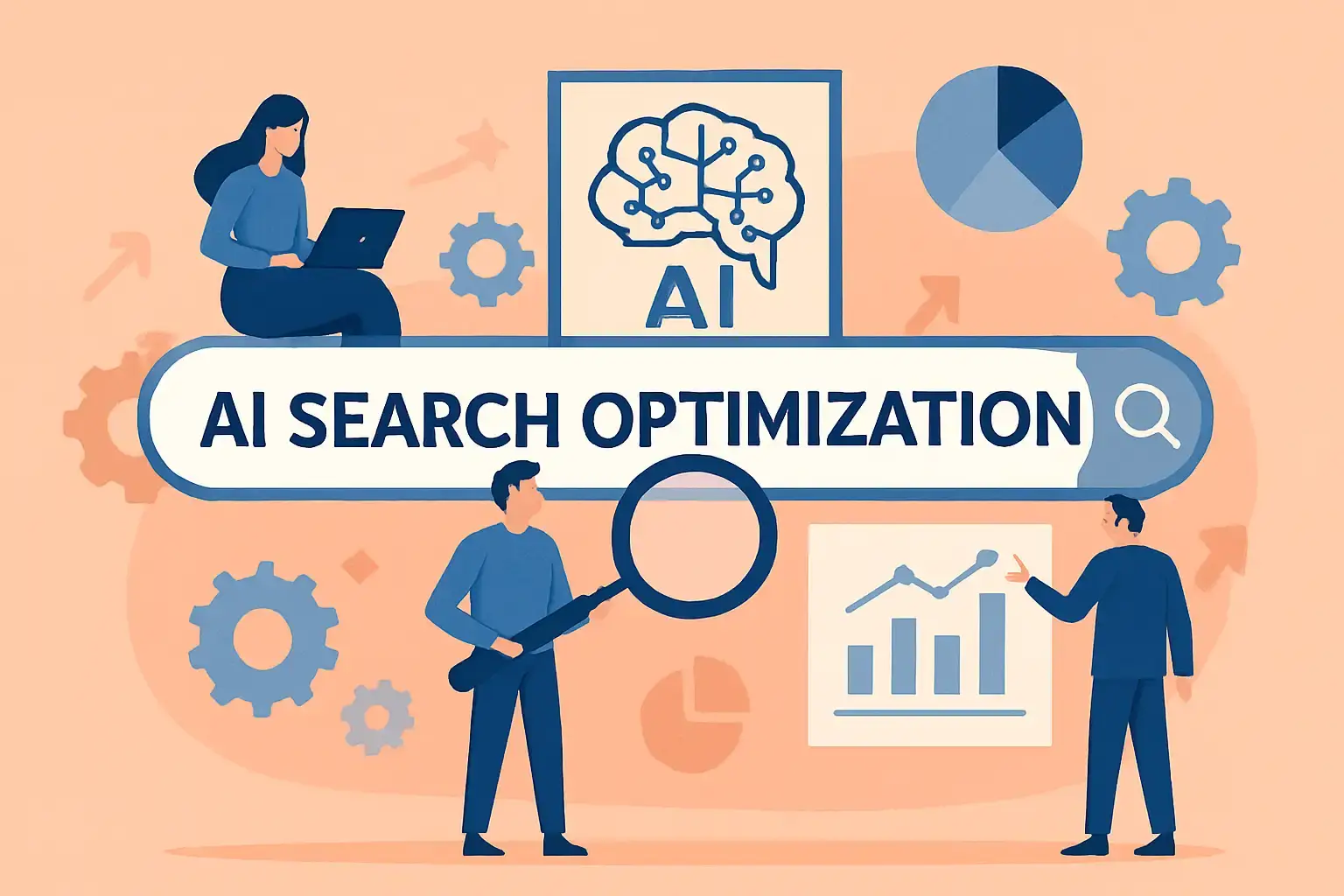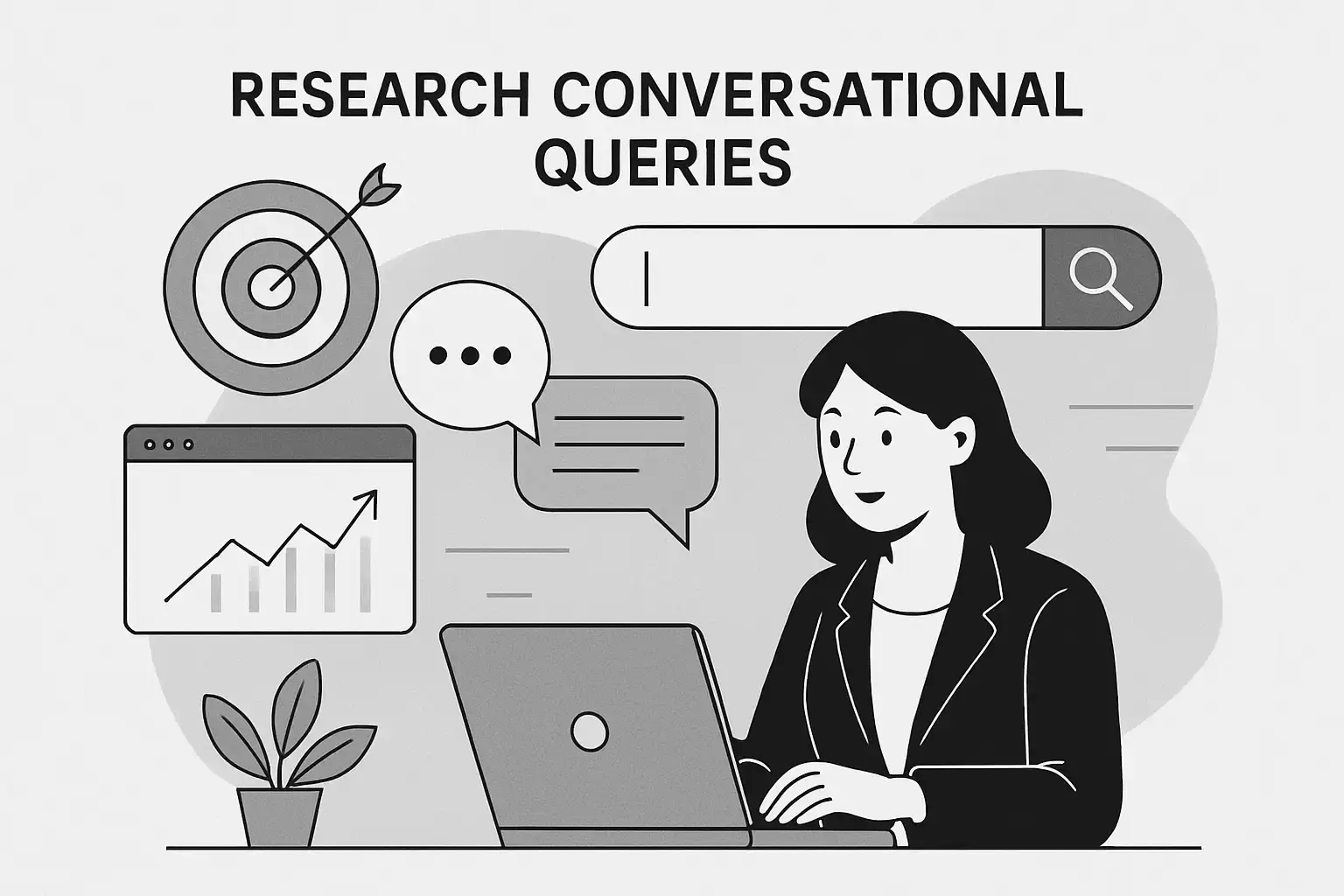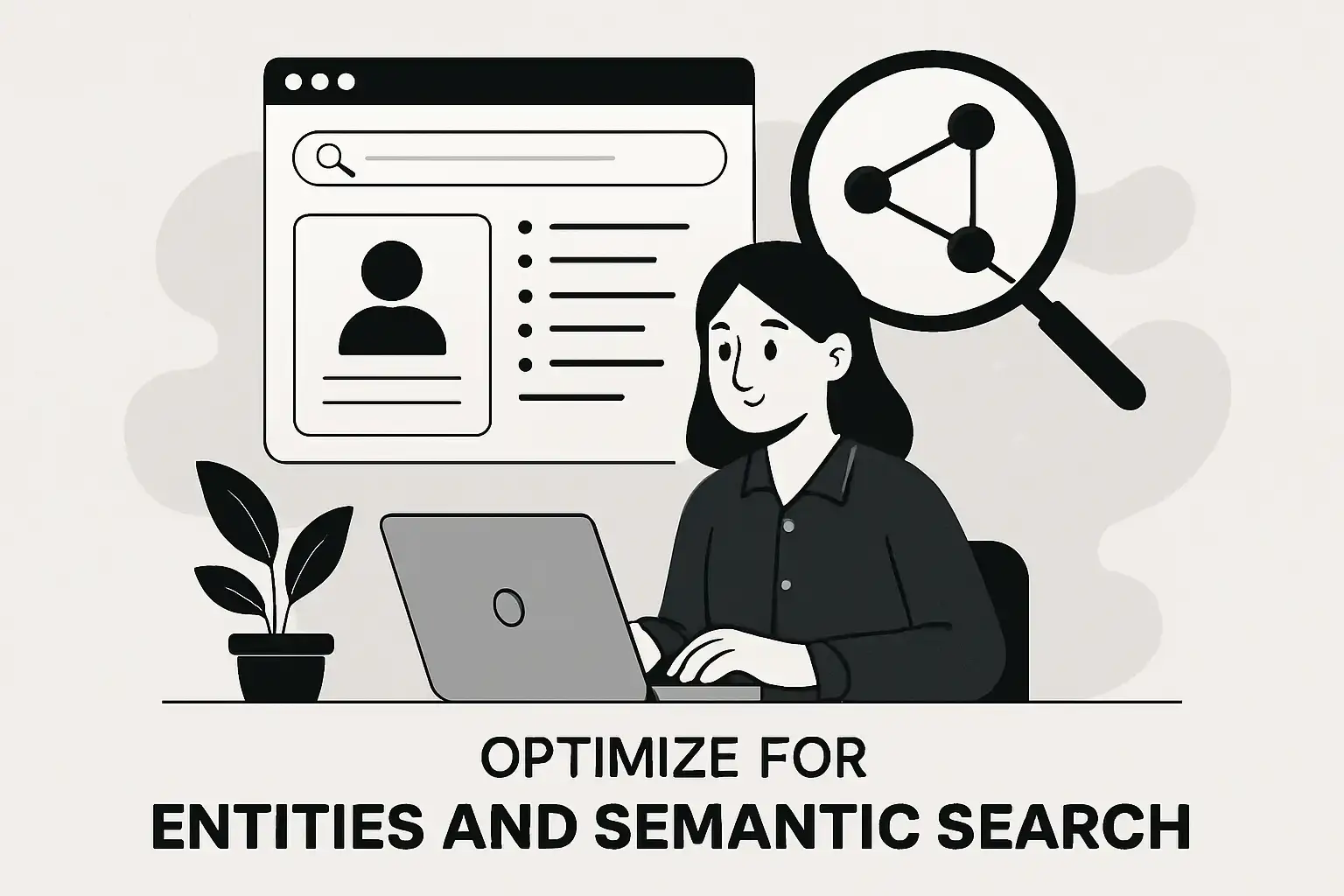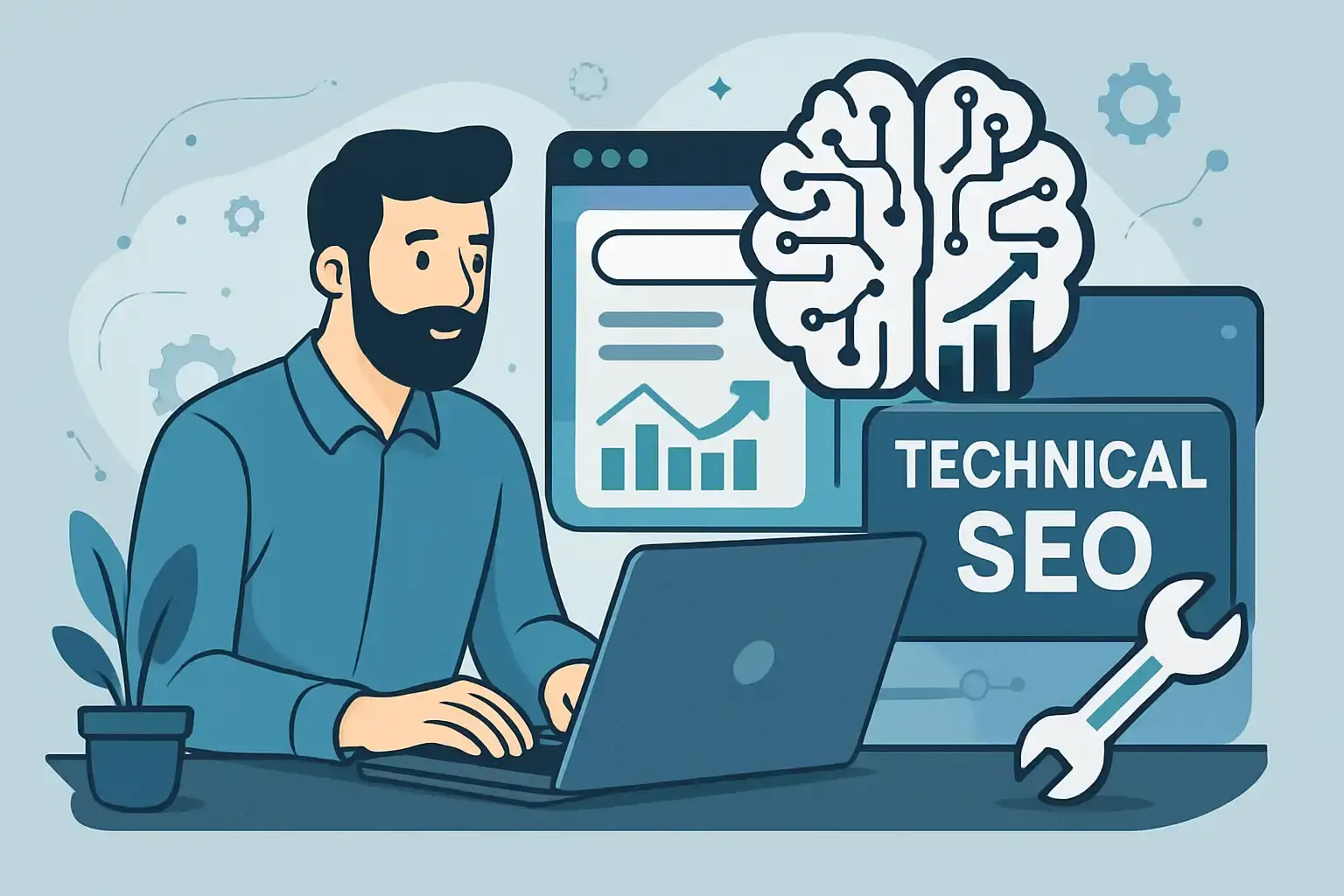Ultimate AI Search Optimization Guide 2025 (AEO, GEO, AIO)

TL;DR — To effectively optimize your business for AI-powered search engines, focus on understanding how AI search algorithms process content, target conversational queries, structure your content for clear answers, optimize for entities and semantic search, and enhance content quality and technical SEO. Implementing these AI SEO best practices and utilizing AI search optimization tools can help your business stay ahead of AI search engine updates and trends in 2025, ensuring your content remains visible and authoritative in the evolving landscape of generative engine optimization.
Table of Contents
What Is AI Search Optimization (AEO) and Why Does It Matter?
If you've been hearing buzz about AI-driven search engines and wondering how to keep your business visible, you're in the right place. AI Search Optimization, or AEO, is the new frontier in making sure your content gets noticed—not just by traditional search engines, but by the smarter, AI-powered ones that are changing the game. To stay ahead, it's essential to understand whether SEO is dying due to AI and how to optimize for AI search.
What exactly is AI Search Optimization or AEO / GEO / AIO?
Think of AEO as the art and science of tailoring your website and content so AI search engines can understand and showcase it better. Unlike classic search engines that mainly look for keywords and backlinks, AI search engines dive deeper. They use natural language processing (NLP) and machine learning to grasp the meaning behind user questions, the context of your content, and what the user really wants.
So, instead of just matching words, AI search engines try to understand your content and deliver answers directly—often in a conversational or summarized way. AEO is about crafting clear, concise, and authoritative content that these AI systems can easily interpret and trust. This means your business has a better shot at being featured right where users see answers, not just links.
How is AEO different from traditional SEO?
You might be wondering, "Isn't this just SEO with a fancy new name?" Not quite. While traditional SEO focuses on keywords, backlinks, and ranking pages, AEO shifts the focus to meaning and intent. It’s about aligning your content with how AI interprets user queries and the relationships between concepts (called semantic relevance).
Here’s a quick comparison:
|
Aspect |
Traditional SEO |
AI Search Optimization (AEO) |
|---|---|---|
|
Focus |
Keywords and backlinks |
User intent, semantics, and context |
|
Content optimization |
Keyword density and link profiles |
Clear, structured, and comprehensive answers |
|
Search results |
Ranking pages with links |
Direct answers, summaries, conversational responses |
|
Trust signals |
Backlinks and domain authority |
Content quality, entity recognition, and authority |
By optimizing for AEO, you’re not just chasing rankings—you’re making your content understandable and valuable to AI, which can boost your chances of being the go-to answer.
Why should businesses care about optimizing for AI-driven search engines?
Here’s the deal: AI-driven search engines are quickly becoming how people find information online. They often show answers right on the search page, which means fewer clicks to your website—but that doesn’t mean less opportunity. In fact, being featured as a trusted source on the search page can massively boost your brand’s visibility and credibility.
Tip: According to recent studies, over 50% of online searches are expected to be handled by AI-powered systems within the next few years. Ignoring AEO means risking your business getting lost in the shuffle as user behavior shifts.
By embracing AEO, you ensure your business stays competitive, attracts qualified traffic, and builds trust—even as search engines evolve. It’s about future-proofing your digital presence and making sure your content speaks the language of AI and your audience alike. For more information about the impact of AEO on organic traffic, check out these 5 important stats on AEO.
Ready to dive deeper? Next, we'll explore the 7 essential steps to master AI Search Optimization and keep your business ahead of the curve.
Step 1: Understand How AI Search Engines Work

To get ahead with AI Search Optimization (AEO), you first need to grasp how AI-powered search engines actually process and rank content. Unlike traditional search engines that mainly matched keywords, AI search engines dive deeper—they analyze the meaning behind your content and how well it answers what users are really asking.
How AI Search Engines Process and Rank Content
AI search engines use advanced natural language understanding and machine learning models to evaluate your content. They look beyond simple keyword matches and focus on:
- User intent: Does your content truly satisfy what the user wants to know?
- Context and semantics: How well does your content cover the topic in depth and relate to other relevant concepts?
- Content quality: Is your information clear, authoritative, and trustworthy?
- Engagement signals: Are users spending time on your page, or quickly bouncing away?
- Technical health: Is your site fast, mobile-friendly, and accessible?
All these factors combine to help AI decide which pages deserve to rank higher or get featured snippets.
What Makes AI-Powered Search Different?
Search engines like Google SGE, Bing AI, and Perplexity have transformed the search experience by adding conversational, interactive layers. Instead of just showing a list of links, they:
- Let users ask complex questions in natural language.
- Provide summarized, direct answers right on the search page.
- Support follow-up questions in a multi-turn dialogue.
- Pull data from multiple sources to give context-aware responses.
This means your content needs to be clear, comprehensive, and structured to fit into these AI-driven answer boxes and chat-like results. For a deep dive, see these 6 big differences of AI Search Optimization vs SEO.
Signals AI Search Engines Look For
To rank well, your content should send the right signals to AI algorithms. These include:
|
Signal Type |
What It Means for Your Content |
|---|---|
|
Semantic relevance |
Use natural language that matches user intent and related topics. |
|
Entity relationships |
Connect concepts and keywords logically within your content. |
|
Structured data markup |
Help AI understand your content’s format and key info. |
|
Content quality & depth |
Provide thorough, accurate, and well-organized information. |
|
User engagement metrics |
Keep visitors interested with engaging, easy-to-read content. |
|
Trustworthiness (E-E-A-T) |
Show expertise, experience, authority, and trustworthiness. |
|
Backlinks |
Earn links from reputable sites to boost authority. |
|
Technical site health |
Ensure fast loading, mobile usability, and accessibility. |
Tip: Studies show that pages with strong E-E-A-T signals and structured data markup are significantly more likely to appear in AI-generated answer boxes and chat responses. So, focus on building authority and making your content easy for AI to parse.
By understanding these AI search engine mechanics, you’re setting a solid foundation for optimizing your content to meet the new standards of discoverability and ranking in the AI era.
Step 2: Research and Target Conversational Queries

When it comes to AI Search Optimization (AEO), targeting conversational queries is a game-changer. Unlike traditional SEO, where you might focus on short keywords, AEO thrives on natural language — the way people actually talk or type their questions. So, how do you find those golden questions and keywords that your audience is really asking?
How to Find the Right Questions and Conversational Keywords
Start by stepping into your audience’s shoes. What problems are they trying to solve? What questions pop up in their minds? Here’s a quick roadmap:
- Dive into keyword tools: Use Google’s Keyword Planner, Ahrefs, SEMrush, and AnswerThePublic to uncover question-based keywords and long-tail phrases.
- Explore Google’s People Also Ask: This feature is a treasure trove of real user questions related to your topic.
- Check forums and social media: Places like Reddit, Quora, and niche Facebook groups reveal authentic conversations and pain points.
- Review customer feedback: Your own customers’ questions and reviews can highlight gaps your content can fill.
- Analyze competitor content: See which questions they’re answering well and where you can offer clearer, more authoritative responses.
Tools That Make Finding AEO-Friendly Queries Easier
Here’s a handy table of tools to help you identify those conversational queries:
|
Tool |
What It Does |
Why It’s Useful for AEO |
|---|---|---|
|
Google Keyword Planner |
Finds keyword ideas and search volume |
Great for initial keyword discovery |
|
Ahrefs |
Provides keyword data and competitor analysis |
Helps spot long-tail and question keywords |
|
SEMrush |
Offers keyword research and content ideas |
Tracks keyword trends and user intent |
|
AnswerThePublic |
Visualizes questions and phrases people ask |
Focuses on natural language queries |
|
Google People Also Ask |
Shows related questions in search results |
Reveals real-time user questions |
|
ChatGPT / Jasper |
AI-generated conversational queries |
Creates natural, human-like question ideas |
Why User Intent and Natural Language Matter in AEO
AI search engines don’t just match keywords—they try to understand why you’re searching. That means your content needs to speak the same language your audience uses and directly address their intent.
Think of it this way: if someone asks, “How do I improve my website’s ranking with AI?” your content should answer that question clearly and conversationally, not just stuff in the phrase “improve website ranking.” This approach boosts relevance, keeps users engaged, and increases your chances of being featured by AI-powered search results.
Pro tip: According to recent studies, over 61% of voice searches are posed as questions or natural sentences. Optimizing for these conversational queries can significantly increase your visibility in AI-driven search results.
By focusing on conversational queries and truly understanding your audience’s intent, you’re setting a solid foundation for your AEO strategy. Next up, you’ll learn how to craft content that answers these questions with clarity and authority.
Step 3: Structure Content for Direct, Clear Answers

When it comes to AI search engines, how you format your content can make all the difference. These engines are designed to quickly find and present the most relevant, straightforward answers to user queries. So, your goal is to make your content easy for AI to understand and easy for users to digest.
How should you format content to get picked up by AI search engines?
Start by organizing your content with clear headings (like H2s and H3s) that break down topics logically. Use bullet points, numbered lists, and tables to present information in bite-sized chunks. For example, instead of a long paragraph explaining a process, try a step-by-step list. This helps AI identify key points and improves your chances of appearing in featured snippets or answer boxes.
Don’t forget to add structured data markup (schema) to your pages. This is like giving AI a cheat sheet that explicitly tells it what your content is about—whether it’s an FAQ, a how-to guide, or a product description. Proper schema markup can boost your visibility in rich results.
Best practices for featured snippets and answer boxes
Featured snippets love concise, direct answers. Aim to provide your main answer within the first 40-60 words of your section. Use lists or tables when you can—they’re easier for AI to parse and for users to scan quickly.
Make sure your content is authoritative and up-to-date. AI favors trustworthy sources, so keep your information accurate and relevant. Also, naturally include keywords that match what your audience is searching for, but avoid keyword stuffing.
Here’s a quick checklist for snippet-friendly content:
- Answer the question clearly and early.
- Use bullet points or numbered lists for steps or tips.
- Include tables for comparisons or data.
- Structure content with proper headings.
- Add FAQ schema or Q&A markup.
Tip: According to recent studies, pages optimized with FAQ schema are 30% more likely to appear in rich results, giving you a significant edge in AI-driven search visibility.
Making your content more AI-friendly
Think of AI as a smart assistant that wants to help users find exactly what they need—fast. To make your content AI-friendly:
- Use natural, conversational language that matches how people ask questions.
- Break down complex topics into simple, digestible parts.
- Sprinkle in semantic keywords and related entities to give context.
- Ensure your site loads quickly and works well on mobile devices.
- Keep your content fresh and trustworthy.
By focusing on clarity, relevance, and structure, you’re not just optimizing for AI—you’re creating a better experience for your visitors, too. And that’s a win-win.
Structuring your content this way sets a solid foundation for AI search success. Next, we’ll dive into how to optimize your keywords and topics for maximum impact.
Step 4: Optimize for Entities and Semantic Search

When it comes to AI search, understanding entities is a game changer. Entities are distinct, identifiable concepts—think people, places, organizations, or things—that AI search engines recognize as unique and meaningful. Why does this matter for you? Because when AI can identify and connect these entities in your content, it better understands the context and relevance of what you offer. This means your content is more likely to show up in the right searches, boosting your visibility and authority.
For more info, check out these common errors to avoid when optimizing for AI Search.
What Are Entities and Why Should You Care?
Entities help AI move beyond simple keyword matching. Instead of just scanning for words, AI looks at the meaning behind them. For example, if you run a coffee shop called "Brew Haven," AI recognizes it as a business entity, not just a random phrase. This recognition allows AI to link your content to broader knowledge graphs—think of them as giant webs of connected information—which can lead to your business appearing in rich search features like knowledge panels or answer boxes.
Using Schema Markup and Structured Data to Speak AI’s Language
One of the best ways to help AI understand your entities is by using schema markup and structured data. This is a type of code you add to your website that explicitly tells AI what your content is about. You can mark up FAQs, how-tos, products, reviews, events, and more using JSON-LD format, which follows schema.org standards.
Here’s why it’s worth the effort:
- Makes your content easier for AI to categorize
- Increases chances of rich results (featured snippets, knowledge panels)
- Improves your site’s credibility and search performance
Don’t forget to regularly validate your structured data with tools like Google’s Rich Results Test to keep everything accurate and compliant.
Tip: Businesses that implement structured data see up to a 30% increase in click-through rates from search results, thanks to enhanced visibility and rich snippets.
Helping AI Understand Your Business Context
Beyond markup, you want to clearly define your brand and services throughout your site. Use consistent naming conventions and detailed About pages that explain who you are and what you do. Link related topics and entities logically within your content to build a clear narrative.
Also, build authority by earning backlinks and citations from reputable sources. This signals to AI that your business is credible and trustworthy, which can boost your rankings in AI-driven search results.
By focusing on entities and semantic search, you’re not just optimizing for keywords—you’re optimizing for meaning. This shift is key to staying competitive as AI continues to reshape how people find information online.
Step 5: Enhance Content Quality and Trustworthiness

When it comes to AI search optimization, quality and trustworthiness aren’t just buzzwords—they’re your secret weapons. AI-driven search engines are getting smarter at spotting content that’s reliable and authoritative, so you want to make sure your site sends the right signals.
What Signals Show AI That Your Content Is Trustworthy and Authoritative?
AI looks at a variety of factors to decide if your content deserves a top spot. Here’s what you need to focus on:
- Backlinks from reputable sources: When respected websites link to you, it’s like a vote of confidence.
- User engagement metrics: Low bounce rates and longer time spent on your pages tell AI people find your content valuable.
- Clear author credentials: Show who’s behind the content with detailed bios and expertise.
- Regular updates: Keep your info fresh and accurate to stay relevant.
- Secure website protocols (HTTPS): Security matters—not just for users but for AI trust signals.
- E-E-A-T principles: Experience, Expertise, Authoritativeness, and Trustworthiness are key.
- Structured data markup: Helps AI understand your content better.
- Transparent business info: Make it easy for visitors and AI to verify who you are.
How E-E-A-T Principles Apply to AEO
E-E-A-T isn’t just a fancy acronym—it’s the foundation of how AI evaluates your content. Here’s how to apply it:
|
Principle |
What It Means |
How to Show It in Your Content |
|---|---|---|
|
Experience |
Real-world knowledge and use cases |
Share case studies, testimonials, or personal insights |
|
Expertise |
Deep subject knowledge |
Highlight credentials, certifications, and detailed info |
|
Authoritativeness |
Recognized as a go-to source |
Earn backlinks, get mentions, and be cited by others |
|
Trustworthiness |
Reliable and honest content |
Use transparent policies, secure your site, and be accurate |
By weaving these principles into your content strategy, you’re telling AI, “Hey, this is the real deal.”
Pro tip: According to recent studies, websites that actively showcase E-E-A-T elements see higher visibility in AI-generated summaries. So, investing in trustworthiness pays off!
Building Credibility for Your Business Online
Credibility doesn’t happen overnight, but these steps will get you there faster:
- Publish consistently high-quality, relevant content that answers your audience’s questions.
- Include detailed author bios with credentials to build trust.
- Earn genuine backlinks from respected sites in your industry.
- Keep your social media profiles active and transparent.
- Make sure your website looks professional, loads fast, and uses HTTPS.
- Engage openly with your audience—respond to comments and feedback.
- Update your content regularly to reflect the latest info and trends.
By focusing on these areas, you’ll build a solid reputation that AI—and your customers—can trust.
Taking the time to enhance your content’s quality and trustworthiness is a game-changer in AEO. It’s about showing AI and your audience that you’re a credible, authoritative source worth ranking highly. Keep these strategies in mind as you move forward with your AI search optimization journey.
Step 6: Improve Technical SEO for AI Search

When it comes to AI search optimization, technical SEO isn’t just a nice-to-have—it’s a must. AI-driven search engines rely heavily on how well your site performs behind the scenes to decide where you rank. Let’s break down the key technical factors you need to focus on and how they impact your AI search visibility.
What Technical Factors Impact AI Search Optimization?
Several technical elements play a crucial role in helping AI search engines crawl, understand, and rank your content effectively:
- Site Speed: Fast-loading pages keep users engaged and help AI bots crawl your site more efficiently.
- Mobile Responsiveness: With most AI searches happening on mobile devices, your site must look and work great on any screen size.
- Secure HTTPS Protocol: Security signals like HTTPS build trust with both users and AI algorithms.
- Clean, Crawlable URLs: Simple, logical URLs make it easier for AI to index your pages.
- Structured Data Markup: Proper schema implementation helps AI understand your content contextually.
- Accessibility Compliance: Ensuring your site is usable by everyone signals quality and trustworthiness.
- Overall Site Health: Minimizing errors, broken links, and duplicate content keeps your site in AI’s good graces.
Why Do Site Speed, Mobile-Friendliness, and Accessibility Matter for AEO?
Think of AI search engines as smart assistants that want to deliver the best experience to users. If your site is slow, clunky on mobile, or hard to navigate for people with disabilities, AI will notice—and so will your rankings.
- Site Speed: A slow site frustrates visitors and increases bounce rates, which AI interprets as a sign of poor quality.
- Mobile-Friendliness: Since many AI searches happen on phones, a responsive design ensures users can easily find and interact with your content.
- Accessibility: Features like alt text, keyboard navigation, and readable fonts make your site inclusive. AI rewards this by boosting your trust signals.
Pro Tip: According to Google, 53% of mobile site visits are abandoned if pages take longer than 3 seconds to load. Speed isn’t just a ranking factor—it’s a user expectation.
Tools to Audit and Improve Your Site for AI Search
You don’t have to guess where your site stands or how to fix issues. Here are some trusted tools that give you clear, actionable insights:
|
Tool |
Purpose |
Why It Helps for AEO |
|---|---|---|
|
Google Search Console |
Track site performance and indexing |
Monitors how AI search engines see your site |
|
Lighthouse |
Comprehensive site audits |
Identifies speed, accessibility, and SEO issues |
|
SEMrush / Ahrefs |
SEO analysis and competitor insights |
Helps optimize content and technical SEO |
|
Screaming Frog |
Technical SEO crawling and audits |
Finds broken links, duplicate content, and crawl errors |
|
GTmetrix |
Website speed testing |
Pinpoints slow-loading elements |
|
Schema Markup Validators |
Validate structured data implementation |
Ensures AI understands your content context |
|
Accessibility Checkers |
Test compliance with accessibility standards |
Improves usability and trust signals |
By regularly using these tools, you can keep your site in top shape for AI search engines and stay ahead of the competition.
Improving your technical SEO might sound daunting, but focusing on these core areas will make your site more AI-friendly and user-friendly—two things that go hand in hand in today’s search landscape.
Step 7: Measure, Monitor, and Adapt Your AEO Strategy

Now that you’ve put your AI Search Optimization (AEO) strategy into action, it’s time to see how well it’s working—and keep it sharp. Measuring, monitoring, and adapting your approach is the secret sauce to staying ahead in the ever-evolving world of AI-driven search.
How Do You Track the Impact of Your AEO Efforts?
Start by keeping an eye on key indicators that show how your content performs in AI search results:
- Organic search traffic: Are more people finding your site through AI-powered queries?
- Keyword rankings: Especially for conversational and question-based searches.
- Featured snippets and answer boxes: Are you showing up in those coveted spots?
- User engagement: Metrics like bounce rate and time on page reveal if visitors find your content helpful.
- Conversion rates: Ultimately, is your traffic turning into leads, sales, or other goals?
Tools like Google Analytics and Google Search Console are your best friends here. They provide a comprehensive view of how your AEO efforts translate into visibility, engagement, and business outcomes.
What Metrics and Tools Should You Use to Measure Success?
Here’s a quick rundown of the most important metrics and tools to keep in your toolkit:
|
Metric |
Why It Matters |
Recommended Tools |
|---|---|---|
|
Organic Search Traffic |
Shows overall visibility and reach |
Google Analytics, SEMrush |
|
Click-Through Rate (CTR) |
Measures how compelling your search snippets are |
Google Search Console |
|
Impressions |
Indicates how often your pages appear in search |
Google Search Console |
|
Rankings for Conversational Keywords |
Tracks your position for AI-friendly queries |
Ahrefs, SEMrush |
|
Featured Snippets Earned |
Highlights your success in capturing answer boxes |
Google Search Console |
|
User Engagement (Dwell Time, Bounce Rate) |
Reflects content relevance and quality |
Google Analytics |
|
Conversion Rates |
Connects traffic to business goals |
Google Analytics |
Using these tools regularly helps you spot what’s working and where you can improve.
Pro Tip: Set up custom dashboards in Google Analytics or your preferred tool to monitor these AEO-specific metrics at a glance. This saves time and keeps your focus sharp.
How Often Should You Update Your AEO Strategy?
AI search engines are evolving fast, and so should your strategy. Aim to review and update your AEO approach at least quarterly. This includes:
- Staying informed about new AI features and algorithm changes.
- Conducting content audits to refresh or expand your answers.
- Running technical SEO checks to ensure your site is optimized for AI crawlers.
- Testing different formats and query types to see what resonates best.
By continuously adapting, you’ll keep your content relevant and competitive in the dynamic AI search landscape.
Remember, mastering AEO is a journey, not a one-time task. With regular measurement and thoughtful tweaks, you’ll build a strategy that grows stronger—and smarter—over time. Keep going; you’ve got this!
Frequently Asked Questions (FAQ)
What are the key AI search ranking factors I should focus on?
Key AI search ranking factors include semantic relevance, entity recognition, structured data markup, content quality, user engagement metrics, backlinks, and technical site health. Optimizing these areas aligns your content with AI search engine optimization steps and improves your chances of ranking higher in AI-driven search results.
How can I improve my website for AI search and voice search optimization AI?
To improve your website for AI search and voice search optimization AI, focus on natural language content, targeting conversational queries, implementing schema markup, ensuring fast mobile responsiveness, and enhancing user experience AI search. These AI search optimization techniques help your content answer voice and AI-driven questions more effectively.
What tools are best for AI search optimization and content optimization?
Effective AI search optimization tools include Google Search Console, SEMrush, Ahrefs, Screaming Frog, and schema markup validators. These tools help analyze technical SEO, track AI search trends 2025, and optimize content for AI search, ensuring your site adheres to AI SEO best practices.
How do I stay updated with AI search engine updates and AI search trends in 2025?
Stay informed about AI search engine updates and trends 2025 by following industry blogs, subscribing to AI SEO newsletters, participating in webinars, and monitoring AI search algorithm updates from major AI-powered search engines like Google and Bing. Regularly updating your AI content optimization strategy ensures you adapt to new AI search algorithm updates.
What is the best way to build an AEO strategy guide for my business?
Developing an AEO strategy guide for your business involves understanding AI search engine optimization steps, researching conversational queries, structuring content for direct answers, optimizing for entities and semantic search, and continuously measuring and adapting your approach. Incorporate AI search optimization tips and best practices to create a comprehensive plan that enhances your business SEO with AI.
